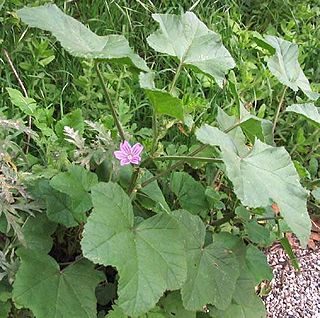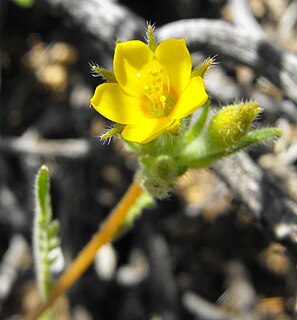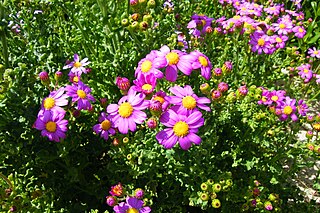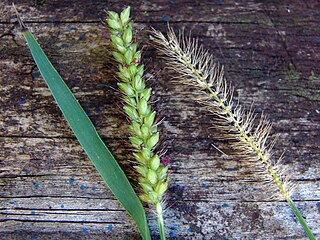
Lepidium perfoliatum is a species of flowering plant in the mustard family known by the common names clasping pepperweed and perfoliate pepperwort. It is native to Europe and Asia and it can be found in other parts of the world as an introduced species.

Atriplex suberecta is a species of saltbush known by the common names sprawling saltbush, lagoon saltbush and Australian orache. It is native to Australia.

Sisymbrium altissimum is a species of Sisymbrium. The plant is native to the western part of the Mediterranean Basin in Europe and Northern Africa and is widely naturalized throughout most of the world, including all of North America. It was probably introduced into North America by a contaminant crop seed. The plant grows in soils of all textures, even sand. The plant germinates in winter or early spring. The blooming time is lengthy, and after maturity the plant forms a tumbleweed. Common names of the plant include Jim Hill mustard, after James J. Hill, a Canadian-American railroad magnate, tall tumblemustard, tall mustard, tumble mustard, tumbleweed mustard, tall sisymbrium, and tall hedge mustard.

Dysphania multifida is a species of flowering plant in the family Amaranthaceae known by the common names cutleaf goosefoot and scented gooosefoot.

Lappula squarrosa is a species of flowering plant in the borage family known by several common names, including European stickseed, bur forget-me-not, bluebur, and bristly sheepbur. It is native to Europe and Asia, where it is common, and it is an introduced species in much of North America and Africa. It is well known as a noxious weed where it is naturalized and also in many parts of its native range. This is an annual herb producing an erect stem often with sprays of many long, bending branches, its form varying in different regions and climates. The plant may approach a meter in height. The stems are lined with linear to oval leaves up to 5 centimeters long and coated in whitish hairs, and the herbage emits a scent generally considered unpleasant. The inflorescence is a long, leafy raceme of tiny flowers near the ends of the branches. Each flower is 2 to 4 millimeters wide with five light blue corolla lobes. White-flowered plants are occasionally seen. The fruit is a cluster of four nutlets which are coated in hooked prickles. The seeds are dispersed when the prickles get caught on animal coats and human clothing, and when they are moved by wind.

Lathyrus sphaericus is a species of wild pea known by the common names grass pea and round-seeded vetchling. It is native to Eurasia and much of Africa, and it is known on other continents as an introduced species. It can grow in many types of habitat, including disturbed areas. This is an annual herb producing a slender stem and bearing leaves each made up of two long, narrow, grasslike leaflets up to 6 centimeters long and a coiling, climbing tendril. The inflorescence is made up of one pea flower on a stalk one or two centimeters long ending a in a bristle. The flower is roughly a centimeter long and deep orange-red or dull red in color. The fruit is a hairless legume pod marked with longitudinal stripes.

Malva nicaeensis is a species of flowering plant in the mallow family known by the common names bull mallow and French mallow.

Mentzelia albicaulis is a species of flowering plants in the family Loasaceae known by the common names whitestem blazingstar, white-stemmed stickleaf, and small flowered blazing star. It is native to much of western North America, where it grows in mountain, desert, and plateau habitat.

Plantago aristata is a species of plantain known by the common name bracted plantain or largebracted plantain. It is native to the eastern and central United States, and it can be found in other parts of North America as well as parts of Eurasia as an introduced species. It grows in many types of habitat, including disturbed areas, where it is a minor weed.

Rorippa palustris, marsh yellow cress, is a species of flowering plant in the family Brassicaceae. It is widespread and native to parts of Africa, and much of Asia, Europe and Eurasia, North America and the Caribbean. It can also be found in other parts of the world as an introduced species and a common weed, for example, in Australia and South America. It is an adaptable plant which grows in many types of damp, wet, and aquatic habitat. It may be an annual, biennial, or perennial plant, and is variable in appearance as well.

Potentilla norvegica is a species of cinquefoil known by the common names rough cinquefoil, ternate-leaved cinquefoil, and Norwegian cinquefoil. It is native to Europe, Asia, and parts of North America, and it can be found elsewhere as an introduced species.

Reseda alba is a species of flowering plant in the reseda family known by the common names white mignonette or white upright mignonette. It is native to Europe, Asia, and North Africa, and it can be found in parts of the Americas and Australia as an introduced species. It is also cultivated as an ornamental plant for its spikelike racemes of fragrant white flowers. This is an annual or perennial herb growing up to a meter tall. The leaves are divided deeply into many narrow lobes. The inflorescence, which may take up most of the upper stem, is densely packed with many white flowers. Each flower has five or six petals, each of which is divided into three long, narrow lobes, making the raceme appear frilly. The fruit is a nearly rectangular four-angled capsule up to 1.4 centimeters in length.

Senecio elegans is a species of flowering plant in the aster family known by the common names redpurple ragwort, purple groundsel, wild cineraria and purple ragwort.

Silene dichotoma is a species of flowering plant in the family Caryophyllaceae known by the common name forked catchfly. It is native to Eurasia and it is known in other parts of the temperate world, such as sections of North America, where it is a weed that grows in disturbed habitat. It is an annual herb growing up to 80 centimeters tall. The lance-shaped leaves are up to 8 centimeters long on the lower stem and are smaller farther up. Each flower is encapsulated in an inflated calyx of sepals lined with ten veins. It is open at the tip, revealing five white to red petals, each with two lobes at the tip and sometimes taking a curled form.

Silene noctiflora is a species of flowering plant in the family Caryophyllaceae known by the common names night-flowering catchfly, nightflowering silene and clammy cockle. It is native to Eurasia, but it is known on other continents as an introduced species and sometimes a weed. In North America, it is a common weed of grain crops in the Canadian prairie provinces and in much of the United States. It grows in fields and in other disturbed habitat.

Sisymbrium loeselii is a species of flowering plant in the family Brassicaceae known by several common names, including small tumbleweed mustard, false London-rocket, throughe(ver:kashmiri) and tall hedge mustard. It is native to Eurasia, and it is known on other continents as an introduced species and in some areas a common roadside weed. It is an annual herb producing a hairy, erect stem which can exceed a meter in height. The leaf blades are divided into triangular, lance-shaped, and toothed linear lobes, and are borne on petioles. The top of the stem is occupied by a raceme of flowers with bright yellow petals each measuring just under a centimeter long. The fruit is a silique up to 3.5 centimeters in length containing tiny seeds.

Solanum triflorum is a species of nightshade known by the common names cutleaf nightshade and small nightshade. It is native to Argentina, but it is known on other continents, including Europe and Australia, as an introduced species and sometimes a weed. It is present throughout much of North America, where it is possibly non-native as well. It grows in many types of habitat, including disturbed areas. It is an annual herb producing spreading, decumbent stems up one meter long. It is hairy, the hairs sometimes associated with glands. The leaves are a few centimeters long and are deeply cut into toothlike lobes. The inflorescence bears two or three flowers each just under a centimeter wide when fully open. The flower is usually white, but is occasionally purple-tinged. The fruit is a berry roughly a centimeter wide.

Trifolium angustifolium is a species of clover known by the common names narrowleaf crimson clover, narrow clover and narrow-leaved clover.

Veronica anagallis-aquatica is a species of flowering plant in the family Plantaginaceae known by the common names water speedwell, blue water-speedwell,brook pimpernel, and sessile water-speedwell. It is also listed as Veronica catenata. Its true native range is not clear, but the plant is present on most continents, and in most places it is probably naturalized. It occurs in many types of moist and wet habitat, and it is semi-aquatic, often growing in shallow water along streambanks, in ponds, and in other wetland environments. It is a rhizomatous perennial herb with stems growing 10 centimeters to about a meter in maximum length. It may be decumbent, the stem spreading along the ground and rooting where it touches moist substrate, or erect in form. The oppositely arranged leaves are green, smooth-edged or toothed, and sometimes clasping the stem where the leaf pairs meet at the bases. The inflorescence is a raceme of many flowers arising from the leaf axils. Each flower is borne on a short, curving pedicel. The flower corolla is up to a centimeter wide with four lobes, the upper lobe being widest. It is blue, lavender, or violet with purple lines near the base of each lobe. At the center are two small protruding stamens.

Setaria parviflora is a species of grass known by the common names marsh bristlegrass, knotroot bristle-grass, bristly foxtail and yellow bristlegrass. It is native to North America, including Mexico and the United States from California to the East Coast, Central America and the West Indies, and South America.




















